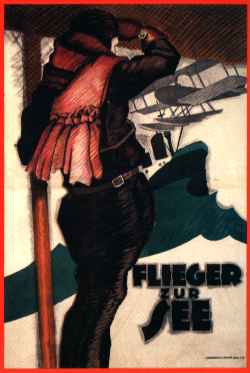Review: NAVAL AVIATION IN THE FIRST WORLD WAR:
ITS IMPACT AND INFLUENCE by R.D. Layman
 |
| Poster by Hans Rudi Erdt |
Reviewed by Michael E. Hanlon (medwardh@hotmail.com)
|
NAVAL AVIATION IN THE FIRST WORLD WAR: ITS IMPACT AND
INFLUENCE Reviewed by Michael E. Hanlon, Research Editor, Relevance My fellow Relevance editor, R.D. Layman, has made a singular contribution to the Great War's historical literature with his latest work: NAVAL AVIATION IN THE FIRST WORLD WAR: ITS IMPACT AND INFLUENCE. Under a barrage of well-aimed facts the misconceptions that World War I aero-naval warfare was merely experimental in nature, minimal in scope, neither fully-embraced by admirals nor admiralties, and generally inconsequential are smashed in this concisely written book. Most important are Mr. Layman's case studies of the successes and missed opportunities of naval aviation in its most significant role of the war, strategic reconnaissance. These included the defense of the Suez Canal, anti- U-boat operations, the Dardanelles/Gallipoli campaign, and, of course, the Battle of Jutland. Two further commendations are due to the author and his editors for covering all theaters of operations equally well (they do not disproportionately focus on the North Sea and Atlantic) and for the tremendous selection of photographs supporting the text. If you have any interest in the air, naval or aero-naval aspects of the war, I would judge this an essential addition to your library. For readers with more general interests, however, I might have to make an equally strong endorsement. There is, first and most important, the case clearly made by the author that his subject is a significant one, impacting many of the Great War's major events. Therefore, this book deserves the attention of all students of the war. Also, though, two qualities of the writer's style and approach to his material make it engrossing for anyone interested in military history. NAVAL AVIATION IN THE FIRST WORLD WAR contains a scattering of unobtrusive, pithy introductions to subjects like aerial combat, how operations differ over land and sea, airship design, and other topics on which much cluttered thinking has been published. These mini-essays serve to clear one's head of both extraneous details and romantic 'aviators as knights' nonsense. The chapter on "Defending the Sea Lanes", for instance, gets to the nub of the tactical usefulness of aircraft in anti-submarine warfare: "The submarine of 1914-18 was for all practical purposes simply a submersible torpedo-boat...At average submerged cruising speed of 4kts, the craft could travel scarcely more than sixty nautical miles before having to surface to recharge...Thus it was by forcing them to submerge, not by sinking them, that aircraft contributed most significantly to helping to defeat the U-boats." Another lesson was of personal interest to me. In six years in the US Air Force, much of it with the now defunct Strategic Air Command, this reviewer never heard as a succinct summary and critique of air power theory as is provided in Chapter Seven of this book. Additionally, during his award-winning career as an aero-naval historian, Mr. Layman has collected an inspired library of fascinating details, anecdotes and surprising statistics. It is impossible to read more than a few pages of his book without just shaking your head in surprise over a new fact. Here are some favorites:
This is just a sampler of the fascinating facts the author has at his disposal. If this fine handbook has any shortcoming, it is that it ends right with the Armistice in 1918. A discussion of how the world's navies, particularly those of Japan and the United States, analyzed the aero-naval lessons of the Great War and converted them to doctrine and ship-building programs would be a fine follow-up to this excellent summary. Nevertheless, for covering naval aviation during World War I, Mr. Layman has provided us a work both thorough and fascinating. NAVAL AVIATION IN THE FIRST WORLD WAR: ITS IMPACT AND INFLUENCE by R. D. Layman can be ordered for $41.95 (including shipping charges) from the Naval Institute Press, 2062 Generals Highway, Annapolis MD 21401. Credit card orders can be placed by phoning 1-800-233-8764 or faxing 1-410-269-7940. © 1997 Michael E. Hanlon - All rights reserved |
